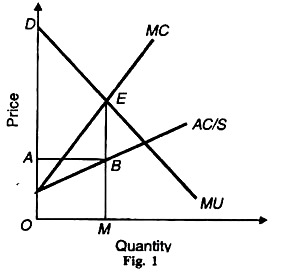The below mentioned article provides short notes on Monopsony Pricing.
Monopsony refers to a market situation when there is a single buyer of a commodity or service. It applies to any situation in which there is a ‘monopoly’ element in buying.
For example, when consumers of a certain commodity are organised, or when a socialist government regulates imports, or when a certain individual happens to have a taste for some commodity which no one else requires, or when a single big factory in an isolated locality is the sole buyer of some grades of labour, there is monopsony.
Monopsony can be formally defined, in the words of Liebhafsky, as “the case of a single buyer who is not in competition with any other buyers for the output which he seeks to purchase, and as a situation in which entry into the market by other buyers is impossible”.
ADVERTISEMENTS:
The analysis of monopsony pricing is similar to that under monopoly pricing. Just as a monopolist is able to influence the price of the product by the amount he offers for sale, similarly the monopolist is able to influence the supply price of his purchases by the amount he buys.
Again, the monopolist aims at the maximisation of his profits, while the monopolist aims at the maximisation of his surplus. The monopolist equates his marginal cost with his marginal D revenue to maximise his profits. The monopolist regulates his purchases in such a way that marginal cost equals marginal utility whereby his consumer’s surplus is the maximum.
The determination of price under monopsony is explained in Figure 1. The supply curve of the industry is the average cost of the monopolist. It is from the industry that he buys the product. This is represented by the curve AC/S in the figure. MC is its corresponding marginal cost curve. MU is the marginal utility curve of the monopolist.
ADVERTISEMENTS:
The monopolist equilibrium is established at E where the marginal utility of the product to the monopolist equals the marginal cost. He buys OM quantity at OA (=MB) price which is the supply price for that output. The surplus obtained by the Quantity monopolist is the area DEBA—the difference between what he is Fig. 1 prepared to pay ODEM and what he actually pays OABM e.g., (DEBA = ОDEM – OABM).
